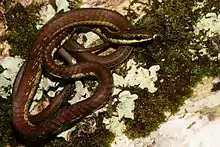Schokar's bronzeback
Dendrelaphis schokari, also known as the common bronze-back[4] or Schokar's bronzeback[5] (Sinhala: තරු/මූකලන් හාල්දන්ඩා, Tharu/Mookalan Haaldanda in Sinhala[4]), is a species of non-venomous arboreal snake in the family Colubridae. The species is endemic to Sri Lanka.[2]
| Schokar's bronzeback | |
|---|---|
 | |
| Scientific classification | |
| Domain: | Eukaryota |
| Kingdom: | Animalia |
| Phylum: | Chordata |
| Class: | Reptilia |
| Order: | Squamata |
| Suborder: | Serpentes |
| Family: | Colubridae |
| Genus: | Dendrelaphis |
| Species: | D. schokari |
| Binomial name | |
| Dendrelaphis schokari (Kuhl, 1820) | |
| Synonyms[2] | |
| |
Habitat and ecology
Dendrelaphis schokari inhabits forests and open areas of all climatic zones of the island of Sri Lanka, from lowlands to about 750 m (2,460 ft) above sea level. It is diurnal, and though a tree snake, it is observed foraging on land as well, in search of its prey, which consist of frogs, lizards, geckos, skinks, insects and also eggs of small birds. It can make long jumps among trees if necessary while chasing its prey. It can be distinguished easily from other Dendrelaphis species by having a cream-colored spotted line on its olive green dorsum from neck to mid fore body along the spine.[3][6][7][8]
Description
Dendrelaphis schokari adult female: snout-to-vent length (SVL) 51 cm (20 in); tail 22.5 cm (8.9 in); 161 ventrals (2 preventrals); 113 subcaudals, all divided; anal shield divided; 1 loreal scale (L+R); 9 infralabials (L+R); first infralabials touch at the mental groove; first sublabial touches infralabials 6 and 7 (L+R); 9 supralabials (L+R), supralabials 5 and 6 touch the eye (L+R); 2 postoculars (L+R); temporal formula: 2+2 (L+R); dorsal formula: 15-15-11; vertebral scales enlarged but smaller than the scales of the first dorsal row; width of the dorsal scale at the position of the middle ventral 2.1 mm; eye-diameter 4.9 mm (L+R); distance anterior border of eye to posterior border of nostril 4.5 mm (L+R); a dark postocular stripe starts behind the eye, covers only the lower quarter of the temporal region and ends at the edge of the jaw; a vertebral stripe, formed by yellow spots on the vertebral scales, starts behind the head and is no longer visible after the level of the 34th ventral scale; an interparietal spot is absent; a faint light ventrolateral line is present, not bordered by black lines; ground color brown, based on the color of unshed skin; supralabials and throat yellow; ventrals yellow anteriorly, yellowish-green posteriorly.[3]: 152 [6]: 33–43 [7]: 81–84 [8]: 583
References
- Wickramasinghe, L.J.M.; Ganesh, S.R. (2021). "Dendrelaphis schokari". IUCN Red List of Threatened Species. 2021: e.T42492396A42492401. Retrieved 23 April 2023.
- Dendrelaphis schokari at the Reptarium.cz Reptile Database. Accessed 29 November 2018.
- Kuhl, Heinrich (1820). Beiträge zur Zoologie und vergleichenden Anatomie. Frankfurt am Main: Verlag der Hermannschen Buchhandlung. LCCN 06002733. 152 pp. (Dipsas schokari, new species, pp. 30-32). (in German and Latin).
- Bushana Kalhara (21 August 2010). "Common bronze-back/තුරු හාල්දණ්ඩා/මූකලන් හාල්දණ්ඩා[Thuru/Mookalan Haal Danda] (Dendrelaphis schokari)". Biodiversity of Sri Lanka: Snakes of Sri Lanka. Retrieved 4 December 2018.
- Sanjaya Bandara (25 January 2018). "Schokar's Bronzeback/කූල්ගේ හාල්දණ්ඩා (Dendrelaphis schokari-Kuhl, 1820)". Snakes of Sri Lanka. Retrieved 4 December 2018.
- van Rooijen, Johan; Vogel, Gernot (2008). "An investigation into the taxonomy of Dendrelaphis tristis (Daudin, 1803): revalidation of Dipsas schokari (Kuhl, 1820) (Serpentes, Colubridae)" (PDF). Contributions to Zoology. 77 (1): 33–43. doi:10.1163/18759866-07701005. S2CID 55045918.
- Werner, Franz (1893). "Herpetologische Nova" (PDF). Zoologischer Anzeiger. 16 (414): 81–84.
- Smith MA (1943). The Fauna of British India, Ceylon and Burma, Including the Whole of the Indo-Chinese Sub-Region. Reptilia and Amphibia. Vol. III.—Serpentes. London: Secretary of State for India. (Taylor and Francis, printers). xii + 583 pp.
